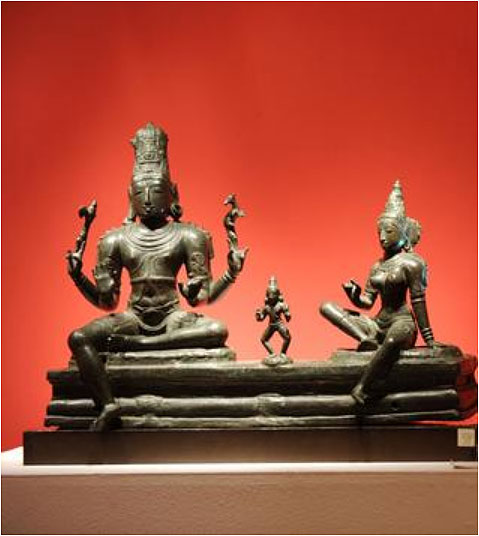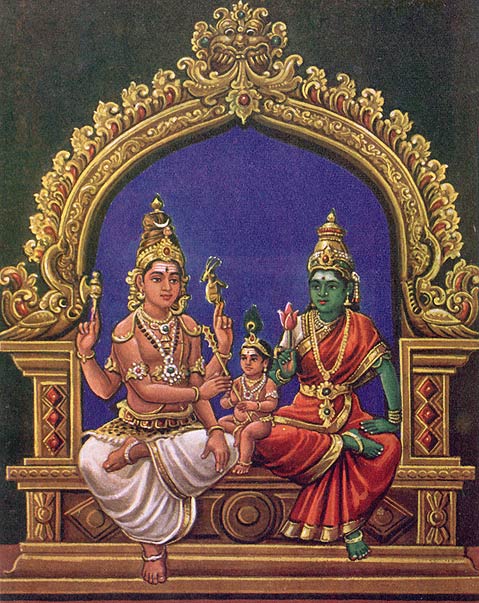
|
||||||
|
| ||||||
The Iconography of Somāskanda Mūrtiby A. Vēlusamy Suthanthiran
There have been many interpretations regarding the Somāskandamūrti aspect of Śiva. The representation of the child Murukan in between Śiva and Umā is mainly intended to emphasize the importance of the child in family life. Tamil works like Puranānūru and Tirukkuraḷ also emphasize the importance of children for a pleasant and congenial society. The Sanskrit work Avanti Sundari Kathā Sara also supports this view. It relates that the queen of the Pallava King Rājasimha, on seeing a painting of Somāskanda in a mandapa, prayed to the god to give her a beautiful child like Skanda depicted in the painting. Another view is that the three figures represent sat, chit and ānanda. Further it is also viewed that the figures Śiva, Umā and Skanda represent lccha-śakti, kriya-śakti and jñāna-śakti respectively (Vaithyalingam 1980: 90). Again Śiva in the company of Umā and Skanda symbolizes universal parentage (Nagaswamy, 1983: 100). The couple is extolled as the Father and Mother of the World (jagata pitarau) by Kalidasa, who has left an immortal epic on the birth of Kumāra, Kumārasambhavam. Kumārakuruparar in his Pirapantatirattu compares the three figures with the three guņas sattva, tamasa and rajasa respectively. Lastly, Somāskandamūrti may be viewed as emphasising the worship of Skanda, who is the enbodiment of Śiva and Umā combined. Iconographical attributes of SkandāskandaIt may be observed that in most all the stone representations of Somāskandamūrti, Skanda is represented in a standard posture. His hands hold flowers. In all the Somāskanda panels of Rajasimha period, Skanda has a peculiar head-dress, a turban-like portion which is pinched in the middle and a tall crown-like portion. Kara have both the makara and patra kuņdalas. In the shore temple at Māmallapuram. Skanda is in sitting posture. The fleshy body as well as the face clearly expose his childlike quality. The karaņda makuṭa is well-knitted. The forehead ornament is prominently exhibited. In the Sāluvankuppam cave temple, the two hands of Skanda are raised to the shoulder level, and the objects in the hands are not clear. Karaņdamakuṭa is a clear depiction. In the Kāñcipuram Kumāra Kōttam temple, there are fragments of painted Sōmaskanda panels (Lockwood, Siromoney and Dayanandan, 1974: 29). The painting present in the cell no. 41 is a beautiful one (Śivarāmamūrti, 1968: 65). The baby Skanda is a noble representation of the age of innocence. A tiny coronet adorns His juvenile head. From his mother's lap, he looks at his father meaningfully. Cōla PeriodIn the Cōla period, bronzes of Sōmaskandamūrti were available in large numbers noted for their artistic excellence and exuberance. Skanda is seen in sitting, standing and dancing postures. One of the best of the early Cōla Sōmaskandas is in the temple of Pallavanīśvarasvāmi in Pallavanīśvaram. The very name of the temple and the village indicates Pallava association. This bronze is clearly of the transitional period from Pallava to Cōla with greater affinity to the Cōla idiom as seen in ninth and tenth century Cōla sculpture. Skanda is sitting in a naturalistic way almost lost in a reverie, in nearly the same fashion as in Pallava groups of Sōmaskanda (Śivarāmamūrti, 1963: 58). Channavīra is prominently executed. Patrakuņdalas adorn the ears. Forehead ornament is well exhibited. The right hand holds the lotus flower and the left seems to be varada. Necklaces are well knitted, and they exhibit intricate designs. The eyes are raised upwards. Koyuras, anklets and wristlets are superbly executed. In the Sōmaskanda group from Vardhamanasvarar temple at Tirutturaippūņṭi, dated in the year A.D. 950, Skanda is seated with crossed legs. Both hands hold flowers. He wears sannavīra and a little garland of flowers around his head. One hand is in kaṭaka mudra and other is in varada. Sōmaskanda from Śivapuram is datable to the middle of the 10th century A.D. The figure of Skanda is a gem indeed. Every feature is treated with precision. Perfection is visible in its modelling. The decoration is more refined. The dancing posture as a whole is rhythmic and superb. The Skanda of the Sōmaskanda group from the Svetaranyesvarar temple at Tiruveŋkāṭu is very graceful. Being in the standing posture, his face exhibits a realistic exposition. The karaņda makuṭa and the waist-band with kinkiņis are stylistically well-executed. Sōmaskanda from Nīdur, Tanjavur district, may be dated to the 11th century A.D. The baby Skanda is represented in a telling manner. The artistic qualities of Skanda are enhanced by the superb style in which ornaments such as karaņda makuṭa, ear rings, necklaces, channa-vira, and waist-bands with a tassel hanging from them on either thigh and pādasāras are depicted. In the group from Vaittīcuvaran Kōvil, dated to the last quarter of the 12th century A.D., Skanda is dancing in the catura pose, with the right leg slightly lifted up and the left arm stretched out in dancing style. The right hand holds a flower. The hair is arranged as keśa-makuṭa fashion. The group from Vēllur-airuverai, Tanjavur district, is dated to the middle of the 12th century A.D. The right hand of Skanda is stretched out in abhaya pose. The left hand is in varada. The group now in the Victoria Museum belongs to the beginning of the 13th century A.D. Skanda stands in the samabhanga pose, holding flowers in the hands. The figure is executed with skill as evidenced by restrained decoration and smoothly flowing lines. The group from Kunnandar Kovil may be dated to the third quarter of the 13th century A.D. The two hands of Skanda hold flowers. The head has jaṭāmakuṭa. Left leg is firm and the right leg is slightly bent to the front. In the group from the Śiva temple at Pangal, two hands of Skanda are stretched. The left leg is firmly planted and the right is bent slightly to the front. In the Tillaiyadi group Skanda holds flowers in the two hands. The legs are in the catura pose. In the Ramanandīsvara group, the left hand hangs down freely and the right hand holds a flower. The two legs are bent to the front slightly. In the Saundarēśvarar temple at Tiruppanaiyur, and the Kōnēśvara temple at Kudavāsal, Skanda sits in padmāsana with hands holding flowers. In the stone example from Tiruvīlimilalai, the posture of skanda is peculiarly represented. The left hand is stretched upwards, and the right hand is in kataka pose. The right leg is bent in such a way, as if he is posed for a fight. Ears have patrakundalas. The best examples of the Paņdya period are at Tirupparankunram, (Ekambaranathan, 1984: 78), and Tiruppangili. In the Vijayanagar period also, quite a number of bronzes were produced. In the year AD 1913, a sculpture was discovered at Nelloor (Gangoli, 1915: 125) that can, on stylistic points of view, be dated to the Vijayanagar period. In standing position, Skanda holds flowers in the two hands. In an example from Hosur, Skanda stands in catura pose, on the back of a bull. Two hands hold lotus flowers. The karanda makuṭa is more lengthy, a characteristic feature of Vijayanagar art. Ornaments are more in number. In the group from Kolumur, Udayarpalayam Taluk also, Skanda is depicted in the same style, except for the hair style, which looks like a fan-wise arrangement. The bāhulamalas and the kuņdalas of the ears are well rendered. In the case of Skanda from Somandarkovil, Kallakkurichi Taluk, the two legs are uniformly projected to the front. Both hands hold flowers. The bāhulamalas and the headdress are excellently treated. The figure of Skanda from Kurralanatasvamin temple at Tirukkurralam depicts a stylistic deviation. The left leg is folded and placed on the āsana. The right leg is in kuṭkutikāsana posture. The head-dress also depicts a deviated style and appears to be kurīṭa makuṭa. Somāskanda in inscriptionsIn an inscription from the Atirannaccanda rock-cut temple at Saluvankuppam, Śiva is referred to as Paśupati, Parvati as Malaimakal and Skanda as Guha. An inscription of the Cōla King Rajadhiraja I mentions this from as Umā-Skanda-sahitam. Somāskanda in the AgamasThe work Srītattvanidhi states that Skanda in Sōmaskanda should be a child with two hands, carrying padmas. Kāśyapa Śilpa-śāstra prescribes sitting, standing and dancing postures. The figure should be naked and must wear channavīra. Of the two hands, left should be in varada carrying a fruit and the right should be in sūci mudrā. The work Silparatna states that the two hands either carry flowers or the left is in varada and the right carries a book. The work also prescribes sitting, standing and dancing postures. In the dancing posture, the work states that the left hand has a fruit and the right in suci pose. Rauravāgama prescribes karaņdamakuṭa and flowers in the hands. It also prescribes sitting, standing and dancing postures. Somāskanda in Tamil LiteratureThe position of Skanda in between Śiva and Pārvati-Skanda as prescribed in Kantapurāņam has been referred to as Kumāravēl. Further the work compares the position of Śiva and Umā to darkness and day respectively. Skanda's position corresponds to dusk, the time in between darkness and light, called evening, mālai in Tamil. Kumāraguruparar in Pirapanta tiraṭṭu refers to the Somāskanda aspect. Skanda has been referred to as Nakilamkulavi, meaning child. In the recent work called Kaumāra maraimai, Skanda has been referred to as matalai in Tamil. From the aforesaid facts one understands the importance of Skanda in Sōmaskanda aspect. Bibliography
This paper was presented at the First International Conference Seminar on Skanda-Murukan, December 1998Dr. A. Velusamy Suthanthiran is the author of A Study of Tiruvengadu Temple and several other books in Tamil. He has presented papers on the iconography of Somaskanda at international conferences in Rome and Naples (1992), as well as numerous papers and lectures at conferences and universities throughout India. He may be contacted at:
Department of Sculpture Other articles from International Conferences on Skanda-Murukan |

